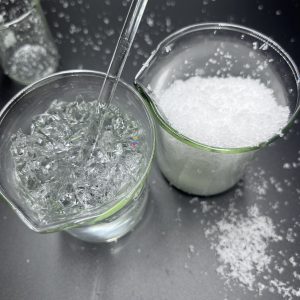What is Potassium Polyacrylate?
Potassium polyacrylate is a superabsorbent polymer (SAP) that can absorb and retain large amounts of water relative to its own mass. It is commonly used in agriculture, horticulture, and various industrial applications due to its excellent water retention properties.
Chemical Composition:
- Chemical Formula: (C3H3KO2)n
- Structure: It consists of a cross-linked network of polyacrylic acid potassium salt.

Manufacturing Process of Potassium Polyacrylate
The production of potassium polyacrylate typically involves the following steps:
- Polymerization: Acrylic acid is polymerized in the presence of a cross-linking agent.
- Neutralization: The polyacrylic acid is neutralized with potassium hydroxide to form potassium polyacrylate.
- Drying and Grinding: The resultant gel is dried and ground into fine particles or crystals.
| Step | Description |
|---|---|
| Polymerization | Acrylic acid polymerizes with a cross-linking agent |
| Neutralization | Polyacrylic acid neutralized with potassium hydroxide |
| Drying | Gel is dried and ground into fine particles or crystals |
Applications of Potassium Polyacrylate
Agricultural Uses
- Water Retention: Potassium polyacrylate crystals can absorb and retain water up to 500 times their weight. This makes them ideal for use in agriculture to improve soil water retention and reduce irrigation frequency.
- Drought Resistance: It helps plants withstand periods of drought by providing a consistent moisture supply.
- Nutrient Retention: It can also help in retaining nutrients in the soil, ensuring they are available to plants over a longer period.
Industrial and Other Uses
- Horticulture: Used in potting soils and garden beds to maintain moisture levels.
- Waste Solidification: Helps in solidifying liquid waste for safer disposal.
- Medical Applications: Used in wound dressings and other absorbent products.
Safety and Environmental Impact
Biodegradability
Potassium polyacrylate is not considered biodegradable. It remains in the environment for an extended period, which raises concerns regarding its long-term impact on soil and water systems.
Safety
Potassium polyacrylate is generally considered safe for use in agriculture and horticulture. However, certain safety precautions should be taken:
- Handling: Avoid inhalation of dust and prolonged skin contact.
- Disposal: Dispose of according to local regulations to avoid environmental contamination.
Toxicity
Studies have shown that potassium polyacrylate is non-toxic to humans and animals when used appropriately. However, ingestion or inhalation of large amounts can cause irritation or digestive issues.
Potassium Polyacrylate vs. Sodium Polyacrylate

Both potassium polyacrylate and sodium polyacrylate are superabsorbent polymers with similar applications. However, potassium polyacrylate is preferred in agriculture due to its potassium content, which is beneficial for plant growth.
| Property | Potassium Polyacrylate | Sodium Polyacrylate |
|---|---|---|
| Absorbency | High | Very High |
| Agricultural Use | Preferred (potassium benefits) | Less preferred |
| Environmental Impact | Biodegradable | Non-biodegradable |
| Safety | Generally safe with precautions | Generally safe with precautions |
Disadvantages of Potassium Polyacrylate
- Cost: It can be relatively expensive compared to other soil amendments.
- Environmental Concerns: Non-biodegradability raises long-term environmental impact concerns.
- Handling Issues: Requires careful handling to avoid dust inhalation and skin irritation.
Market and Availability
Potassium polyacrylate is widely available for purchase in various forms, including crystals and hydrogels. The price varies depending on the purity, form, and quantity.
Price Range
| Form | Price (per kg) |
|---|---|
| Crystals | $3 – $8 |
| Hydrogel | $3 – $5 |
Where to Buy
Potassium polyacrylate can be purchased from agricultural supply stores, online marketplaces, and specialized chemical suppliers.
Conclusion
Potassium polyacrylate is a versatile and effective superabsorbent polymer with significant applications in agriculture and horticulture. While it offers numerous benefits in water retention and drought resistance, considerations around cost, handling, and environmental impact are essential for its sustainable use.
Indexed Keywords:
- Potassium Polyacrylate: Introduction, applications, safety, and market.
- How to Make Potassium Polyacrylate: Manufacturing process and steps.
- Potassium Polyacrylate Agriculture: Benefits and uses in farming.
- Potassium Polyacrylate Crystals: Form and application.
- Potassium Polyacrylate Disadvantages: Costs and environmental concerns.
- Potassium Polyacrylate for Plants: Usage and benefits.
- Potassium Polyacrylate for Sale: Availability and price.
- Potassium Polyacrylate Hydrogel: Form and usage.
- Potassium Polyacrylate Polymer: Chemical composition and structure.
- Potassium Polyacrylate Price: Market price range.
- Potassium Polyacrylate Uses: Various applications.
- Potassium Polyacrylate vs Sodium Polyacrylate: Comparison and uses.
- Sodium Polyacrylate vs Potassium Polyacrylate: Differences and preferences.
- What is Potassium Polyacrylate: Definition and properties.
- Polyacrylate de Potassium: French term for potassium polyacrylate.
- Potassium Polyacrylate Manufacturing Process: Steps and description.
- Potassium Polyacrylate MSDS: Material Safety Data Sheet.
- Potassium Polyacrylate Toxicity: Safety and health impact.
If you have any specific queries or need more detailed information, feel free to ask!

